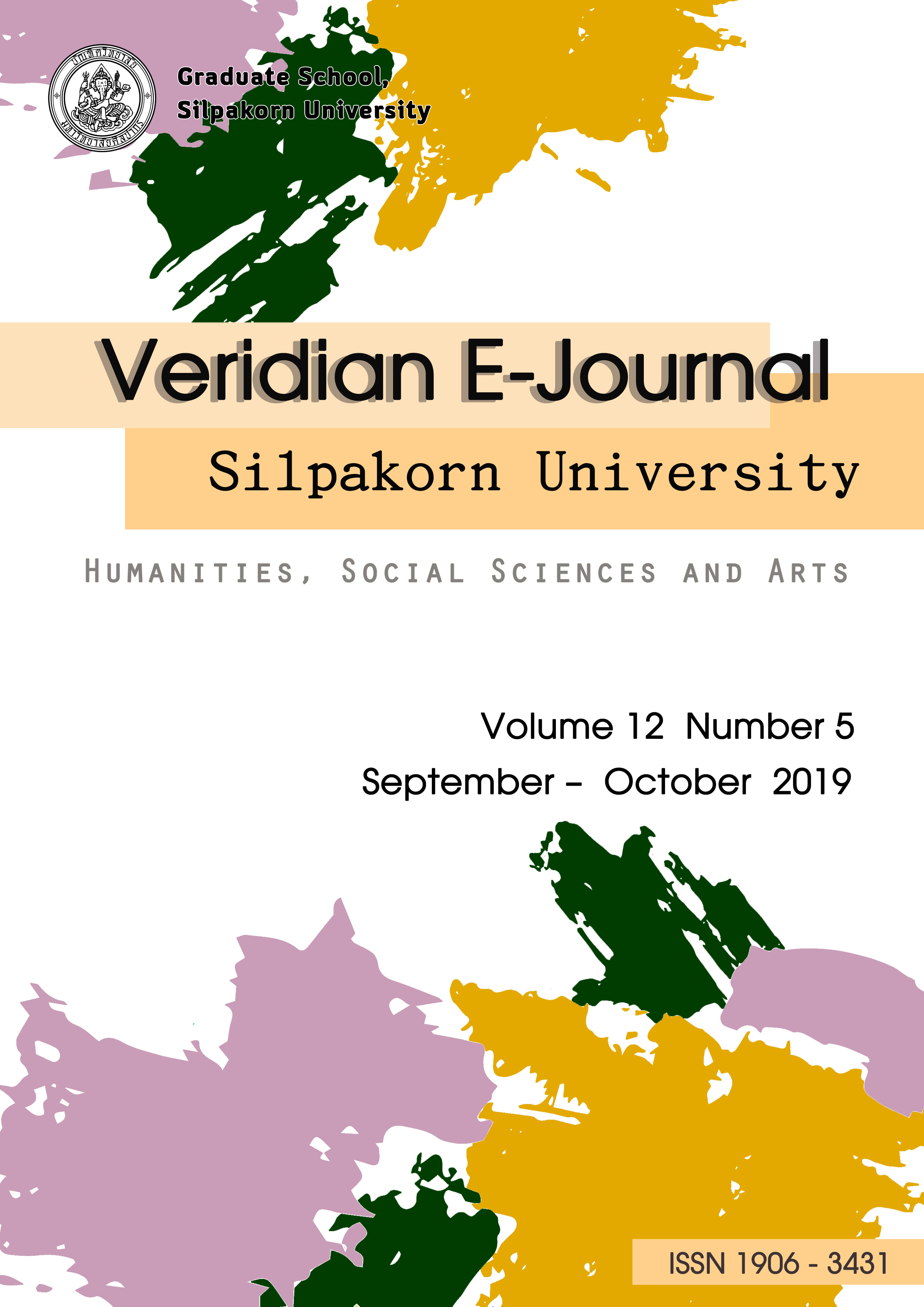แนวทางการจัดกิจกรรมศิลปะเพื่อส่งเสริมสันติวัฒนธรรมสำหรับเยาวชนไทย (Guidelines for Organizing Art Activities to Promote Peace Culture For Thai Youth
Main Article Content
Abstract
การวิจัยนี้มีวัตถุประสงค์ เพื่อ (1) ศึกษารูปแบบการจัดกิจกรรมศิลปะที่ส่งเสริมสันติวัฒนธรรม และ (2) นำเสนอแนวทางการจัดกิจกรรมศิลปะเพื่อส่งเสริมสันติวัฒนธรรมสำหรับเยาวชนไทย กลุ่มตัวอย่างที่ใช้ใน การวิจัยคือ 1) เอกสารและงานวิจัยที่เกี่ยวข้องทั้งในและต่างประเทศ 2) การสังเกตกิจกรรมศิลปะที่เป็นแนวปฏิบัติที่ดีในการส่งเสริมสันติวัฒนธรรมเชิงลึก จำนวน 6 กิจกรรม 3) ผู้เชี่ยวชาญด้านสันติวัฒนธรรม 2 ท่าน 4) ครูและอาจารย์ศิลปะ 4 ท่าน และ 5) ผู้อำนวยการโรงเรียน 4 ท่าน โดยใช้ระเบียบวิธีวิจัยแบบผสมผสาน เครื่องมือที่ใช้ในการวิจัยได้แก่ แบบวิเคราะห์เอกสาร แบบสังเกต แบบประชุมกุล่มและแบบสัมภาษณ์แบบกึ่งมีโครงสร้างแล้วนำข้อมูลทั้งหมดที่ได้มาวิเคราะห์เชิงเนื้อหา (Content Analysis) และสรุปเป็นแนวทางในการจัดกิจกรรมศิลปะเพื่อส่งเสริมสันติวัฒนธรรมสำหรับเยาวชนไทย
ผลการวิจัยพบว่า แนวทางในการจัดกิจกรรมศิลปะเพื่อส่งเสริมสันติวัฒนธรรมสำหรับเยาวชนไทยในสามจังหวัดชายแดนภาคใต้ ที่มีอายุ 12-14 ปี ควรส่งเสริมให้เยาวชนรู้จักตนเอง มีจิตใจที่สงบ มั่นคงทางอารมณ์ ลดอคติต่อผู้อื่น เพื่อสร้างความ เข้าใจที่ดี และอยู่ร่วมกันอย่างสันติสุข รูปแบบกิจกรรมศิลปะเพื่อส่งเสริมสันติวัฒนธรรมเป็นกิจกรรมเดี่ยว คู่และกลุ่ม โดยใช้ศิลปะประเภททัศนศิลป์ได้แก่ ภาพถ่าย ศิลปะประดิษฐ์ สีน้ำ และประติมากรรม ซึ่งกิจกรรมศิลปะที่ส่งเสริมสันติวัฒนธรรมยึดหลักการการ จัดการเรียนรู้ศิลปะที่เรียกว่า 8 Studio Habits of Mind (Hetland Winner, et a, 2013) เป็นการจัดการเรียนรู้ตามแนวทาง SHoM ไม่จำเป็นต้องทำตามลำดับขั้นตอน ทำให้ผู้เรียนมีความอิสระและค้นหาตนเองได้ง่าย ขึ้น และกระบวนการจัดกิจกรรมศิลปะใช้กระบวนการจัดการเรียนรู้ศิลปะตาม LTTA Model (สริตา เจือศรีกุล, 2559) ได้แก่ (1) ขั้นรับรู้ เป็นขั้นชี้แจงจุดประสงค์การทำกิจกรรม (2) ขั้นเชื่อมโยง เป็นขั้นที่วิทยากรโยนคำถามหรือหัวข้อให้เยาวชนได้เชื่อมโยงกับสิ่งที่ทำ (3) ขั้นสร้างสรรค์ เป็นขั้นลงมือสร้างสรรค์ผลงานศิลปะ (4) ขั้นนำเสนอ เป็นขั้นนำผลงานศิลปะนำเสนอต่อหน้าทุกคน (5) ขั้นแลกเปลี่ยน เป็นขั้นอธิบายความรู้สึกหรือความคิดเห็นที่ได้ทำงานศิลปะและ (6) ขั้นสะท้อนคิด เป็นขั้นแสดงความคิดเห็นและความรู้สึกที่ได้ทำกิจกรรมในแต่ละครั้ง สำหรับขั้นนำเสนอ ขั้นแลกเปลี่ยนและขั้นสะท้อนคิด เรียกอีกอย่างหนึ่ง คือ กระบวนการสุนทรียสนทนามี 3 ขั้นหลักๆ ขั้นแรกการฟังให้ละเอียด (Deep Listening) ขั้นที่สองการไตร่ตรองความคิด (Reflection) และขั้นสุดท้าย การนำเสนอความคิด (Advocacy) (มนต์ชัย พินิจจิตรสมุทร, 2552) บทบาทและหน้าที่วิทยากรเป็นผู้ให้ออกแบบและควบคุมการดำเนินกิจกรรมภายใต้บรรยากาศที่อิสระและปลอดภัย วิทยากรเป็นผู้ให้คำปรึกษา ผู้ช่วยเหลือผู้สังเกตและประเมินผลในขณะดำเนินกิจกรรม จำนวนผู้เข้าร่วม 15-20 คน ระยะเวลาจัดกิจกรรม 8 ชั่วโมง หรือ 1 วัน การวัดและประเมินผลใช้การสังเกตพฤติกรรมของเยาวชนระหว่างทำกิจกรรมศิลปะและทำกิจกรรมสุนทรียสนทนา และใช้แบบวัดความพึงพอใจหลังการทำกิจกรรม
The purpose of this research were to (1) study the form of art activities that promote cultural peace and (2) present guidelines for organizing art activities to promote cultural peace for Thai youth. The samples used in this research are 1) Documents and research related to domestic and foreign research 2) In-depth observations about the organizing of art activities that are good practices in promoting peaceful culture in a total of 6 activities 3) 2 experts in peace culture 4) 4 teachers art teachers and 5) 4 school directors. The Emergence of Mixed Methods. The instruments used Document analysis form, Observation form and semi-structured interview. And then bring all the information received to analyze content and summarizing guidelines for organizing social activities
The research found that Guidelines for organizing activities Art for promoting peace cultural for Thai youth should have the following guidelines: Art activities that promote cultural peace for youths in the three southern border provinces, ages 12-14 years. This research has aims to let Young people know themselves, calm mind, emotional stability and unbiased to create a good understanding and live together in peace. Format art activities are single, dual activities and group activities. And use various visual arts as media. Which art activities that promote Peace Culture use the principles of art learning management called 8 Studio Habits of Mind (Hetland Winner, et a, 2013) It is a learning management based on the SHoM guidelines. There is no need to follow the steps and it is makes learners more independent and easier to find themselves. And the process of organizing art activities using the art learning process according to LTTA Model (Juaseekoon, 2016) include (1) Recognition Is a step to clarify the purpose of the activities (2) Linking steps is a step that the speaker threw questions or topics for the youth to connect with what was done (3) Creative is a step to create creative works of art (4) Presentation process is a step in bringing the artwork to present in front of everyone (5) Exchange is an exchange by explaining the feelings or opinions that have worked for art and (6) Reflection is a step to express opinions and feelings that have been made in each activity For presentation Exchange and reflection Also called the process of aesthetic conversation. There are 3 main steps. First listening to the deep, second step reflection and final presentation of ideas. (Phinitjitseung, 2009). The role and duty of the speaker is to design and control the activities under the free and safe atmosphere. Is a consultant, helper, observer and assessor while conducting activities. The role and duty of the speaker is to design and control the activities under the free and safe atmosphere, who is a consultant. helpers, observers and evaluators during the activities. The number of participants is 15-20 people. Event duration is 8 hours or 1 day. Measurement and evaluation, use of observation of youth behavior during art activities and activities in conversation And use the satisfaction measure after the activity.

